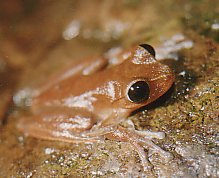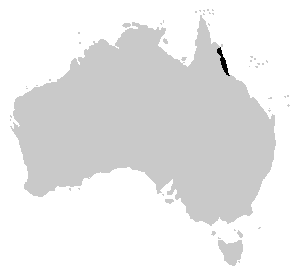Australian lace-lid facts for kids
Quick facts for kids Australian lace-lid |
|
|---|---|
 |
|
| Conservation status | |
| Scientific classification | |
| Genus: |
Ranoidea (genus)
|
| Species: |
dahlii
|
 |
|
| Synonyms | |
|
|
The Australian lace-lid, also called the Day's big-eyed tree frog or lace-eyed tree frog (Ranoidea dayi), is a type of tree frog that lives in Australia. You can find it in the rainforests of northeastern Queensland.
Contents
About the Australian Lace-lid
This frog is about 5.0 cm long when it's an adult. That's about the length of your thumb!
Male Australian lace-lids are quite unique. Unlike many other male frogs that sing together in groups, these males always keep at least 1 meter apart when they call out. Scientists believe this is because they are territorial. This means they compete with each other for space and to attract female frogs.
Where They Live and What They Eat
The Australian lace-lid lives in rainforests. They especially like rainforests found in mountains.
These frogs are not picky eaters. They will eat almost any small creature they can catch. Their diet usually includes invertebrates, such as spiders and different kinds of insects. Their big eyes are very helpful for hunting at night when it's dark.
Life Cycle of the Frog
Female Australian lace-lids lay their eggs under rocks in streams. They choose places where the water flows quickly.
The eggs are clear and small, about 3.3 to 3.5 millimeters across. When the tadpoles hatch, they have strong tails. This helps them swim well in the fast-moving water. The tadpoles eat algae that grows on the bottom of the stream.
Tadpoles that hatch early in the season grow into frogs in about 3 to 4 months. However, if tadpoles hatch in the fall, they might stay as tadpoles all through the winter. They will then turn into frogs the following year.
Why This Frog is Endangered
Sadly, the Australian lace-lid is an endangered species. This means there are not many of them left, and they are at risk of disappearing forever. Scientists are still trying to figure out exactly why this is happening.
One idea is that feral pigs are causing problems. These wild pigs have moved into the frogs' rainforest homes. They dig up and destroy the low-growing plants that the frogs like to climb on and hide in.
Another possible reason is a fungal disease called chytridiomycosis. This disease is caused by a type of fungus that can be deadly to frogs and other amphibians. It's thought to be harming many frog populations around the world, including the Australian lace-lid.
See Also
 In Spanish: Ranoidea dayi para niños
In Spanish: Ranoidea dayi para niños


